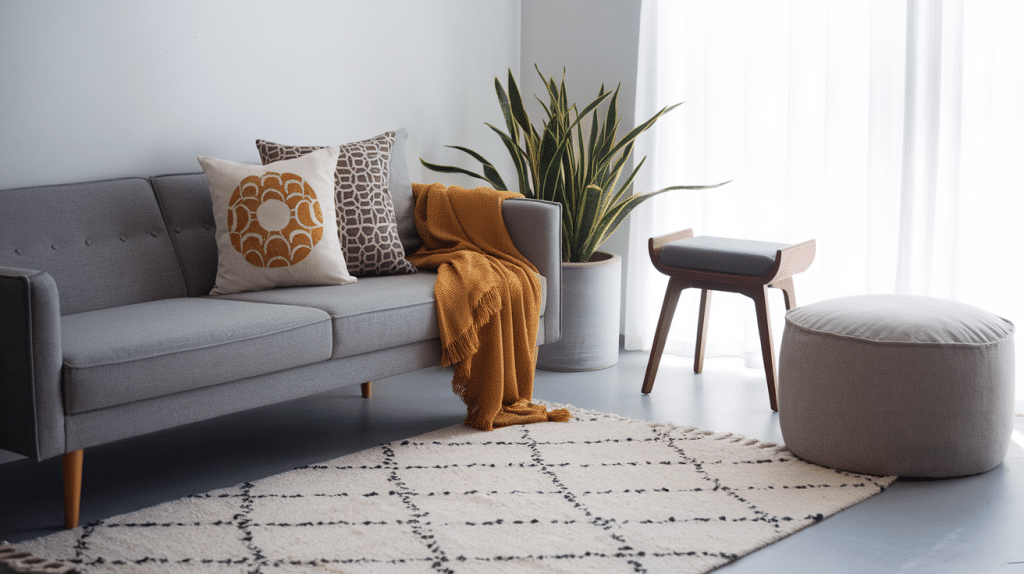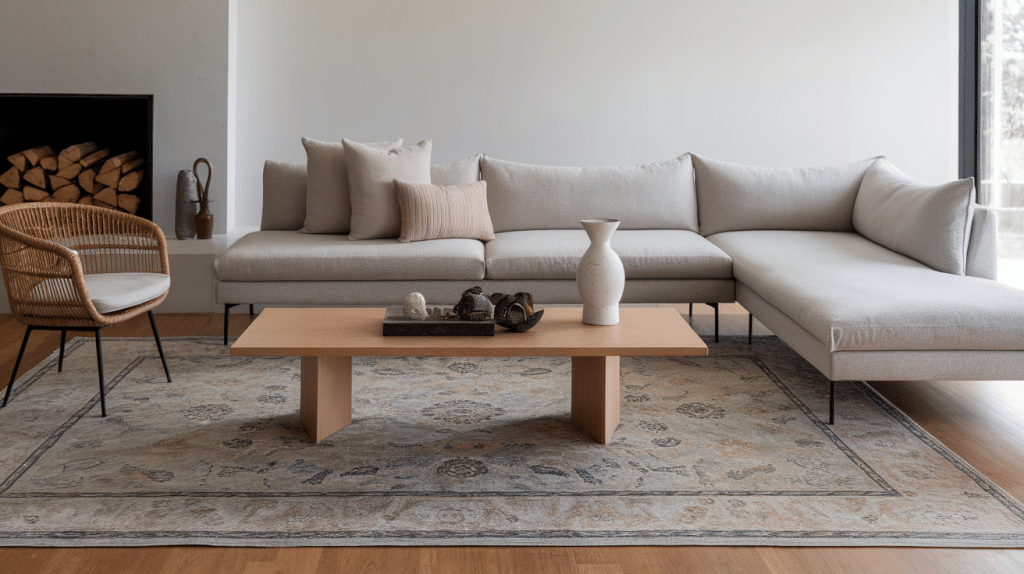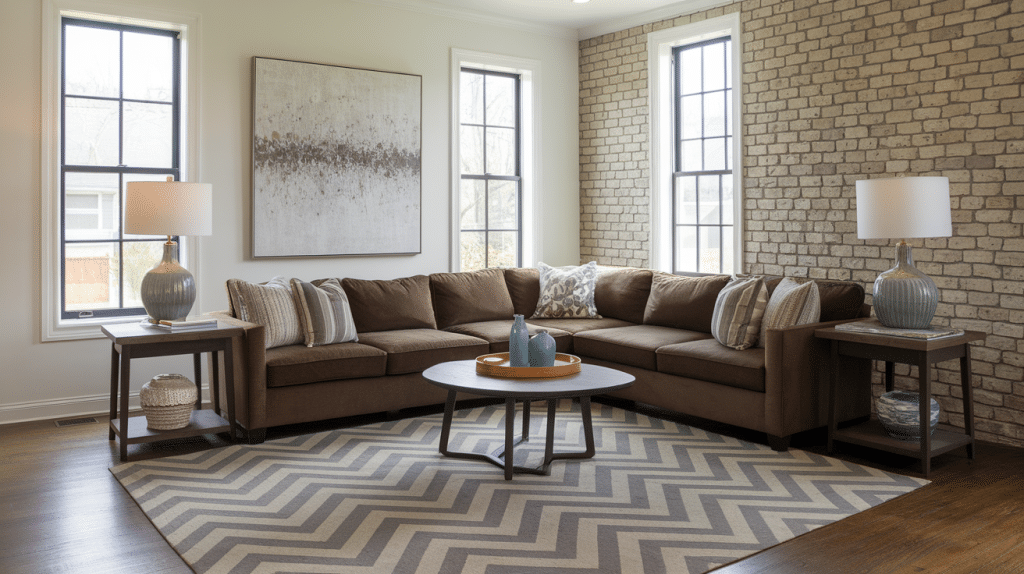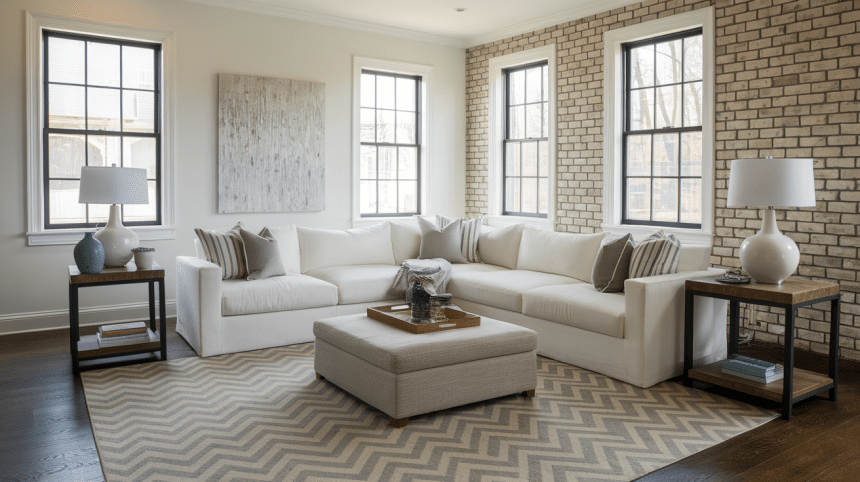That awkward moment when your rug looks like it’s running away from your sectional.
Getting rug placement right with a sectional sofa feels tricky. Too small, and it looks lost. Too big and it swallows the room.
Sectionals are wonderful. They seat everyone for movie night. They create cozy conversation areas. But they can make rug shopping feel like solving a puzzle.
The good news? There are simple rules that work every time, no measuring tape gymnastics required.
Even if sectional is huge or compact, L-shaped or curved, the right rug can tie everything together. It can make your living room feel pulled together and inviting.
Let’s figure out how to make your sectional and rug work together like they were meant to be best friends.
Choosing the Right Rug Size for Your Sectional Sofa
Getting the size right is half the battle. A rug that’s too small makes your sectional look like it’s floating in space. A rug that’s too large can overwhelm your entire room.
Measure Your Space
Start with the basics. Grab a measuring tape and measure the area where your sectional sits. Don’t just measure the sofa itself – measure the whole space around it.
Include the walking paths around your sectional. Think about where people will walk. Consider the coffee table space. Add about 18-24 inches on each side for comfortable movement.
Write down these measurements. You’ll need them when you go rug shopping. This simple step saves you from buying the wrong size and having to return it later.
Rug Size Guidelines
Most sectionals work well with these common rug sizes. Here’s what works best for different situations.
- 5×8 rugs work for smaller sectionals in cozy spaces. They’re perfect for apartments or smaller living rooms. This size usually fits under the front legs of most sectionals.
- 8×10 rugs are the most popular choice. They work well with medium-sized sectionals. This size gives you good coverage without overwhelming the room.
- 9×12 rugs suit larger sectionals and spacious rooms. They can fit completely under most sectionals with room to spare. This size creates a luxurious, hotel-like feel.
Remember, these are starting points. Your room might need something different based on its layout and your sectional’s size.
Full Coverage or Partial Coverage
You have two main options here. Both can look great when done right.
- Full coverage means the entire section sits on the rug. This creates a cohesive, pulled-together look. It works best in larger rooms with bigger rugs.
- Partial coverage means only the front legs of your sectional touch the rug. This approach works well in smaller spaces or with smaller rugs. It still connects the pieces without requiring a huge rug.
The key is being intentional. Don’t let just one leg accidentally touch the rug. That looks like a mistake.
Creating Balance
The rug should feel right with both your sectional and your room. Too small and it looks like it’s floating. Too big and it takes over the space.
A good rule of thumb: the rug should be large enough to anchor the seating area. But it shouldn’t touch all four walls of the room.
Methods of Rug Placement Around a Sectional Sofa

Now comes the fun part – deciding exactly where to put that rug. There are several tried-and-true methods that work well with sectionals. Each approach creates a different look and feel in your room.
1. Under the Sectional
Placing the rug completely under your sectional creates the most cohesive look. The entire sectional sits on the rug, along with your coffee table.
This approach works well in larger rooms where your sectional is the main focus.
2. Partially Under the Sectional
This is probably the most common approach. Only the front legs of your sectional rest on the rug. The back legs stay on the floor.
This method works well with 8×10 rugs and medium-sized sectionals. It’s also more budget-friendly than buying a huge rug.
Make sure the rug extends at least 6-8 inches beyond the front of your sectional.
3. Floating Rug
A floating rug sits in front of your sectional without touching it. This creates visual interest and works well when your sectional is pushed against walls.
Leave 12-18 inches between the rug and the sectional. Too close looks like a mistake. Too far looks disconnected.
4. Rug Placement in Open-Concept Rooms
Open-concept spaces need special consideration. Use your rug to create boundaries and clearly mark where the living room area begins and ends.
Consider the sight lines from other areas. Your rug placement should look good from the kitchen and dining room, too.
Considerations for Rug Placement

Size and placement are just the beginning. There are other important factors that can make or break your rug setup. These details might seem small, but they make a huge difference in how your room looks and functions.
Room Traffic Flow
Don’t let your rug block natural walking paths. People should be able to move around your room easily. Think about how people enter your living room.
Tip: Walk around your room at different times of day to test how the rug placement affects your daily movement patterns.
Visual Balance
Your rug should complement your sectional, not compete with it. If your sectional is bold and colourful, consider a more neutral rug. Consider the other elements present in your room too.
Tip: Take a photo of your room to see how all the colors and patterns work together—the camera often shows what your eyes miss.
Textural Harmony
Mix textures thoughtfully. If your sectional has smooth leather, a textured rug adds interest. If your sectional has nubby fabric, a smooth rug provides balance. Consider practicality too.
Tip: Run your hand over different rug samples to feel the texture before buying—what looks good might not feel comfortable underfoot.
Common Mistakes to Avoid

Even with the best intentions, it’s easy to make mistakes that throw off your whole room. These common errors can make your space look awkward or unfinished. Learning what to avoid helps you get it right the first time.
Choosing the Wrong Size
Size mistakes are expensive and frustrating. Getting it wrong the first time means returns, exchanges, and starting over.
- Too small rugs are the most common mistake. They make your sectional look like it’s floating. They also make the room feel disconnected and awkward.
- Too large rugs can overwhelm smaller rooms. They can also make your sectional look lost in the space. The rug should enhance your furniture, not dwarf it.
When in doubt, go slightly larger rather than smaller. It’s easier to work with a rug that’s a bit big than one that’s too small.
Incorrect Placement
Even the perfect rug can look wrong if placed carelessly. Your room’s layout deserves thoughtful consideration, not random guesswork.
- Don’t place your rug randomly. Be intentional about where it sits. The placement should look purposeful, not accidental.
- Avoid placing rugs at weird angles unless your sectional is angled too. Keep things aligned and parallel for the most pleasing look.
- Don’t let just one leg of your sectional touch the rug. This looks like a mistake rather than a design choice.
Overloading with Patterns
Less is more when it comes to patterns and colors. Too much visual noise turns a relaxing space into a chaotic one.
- Don’t use too many patterns in one space. If your sectional has patterns, keep your rug simple. If your rug has patterns, keep your throw pillows simple.
- The same goes for colours. Too many competing colours create chaos rather than harmony. Choose a colour palette and stick to it.
- Remember, your rug is just one element in the room. It should work with everything else, not dominate the space.
Creating Your Perfect Setup
Every room is different. These guidelines give you a starting point, but don’t be afraid to adjust based on your specific space.
Try different placements before you commit. Many stores let you return rugs if they don’t work. Use this to your advantage.
Your living room should reflect your personality and work for your life. The perfect rug placement is the one that makes you happy every time you walk into the room.
Take your time with this decision. You’ll be looking at this setup every day. It’s worth getting it right.
What works for your neighbor might not work for you. Trust your instincts and create a space that feels like home.

